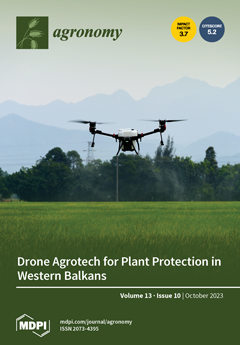Reliable prediction of winter bread wheat grain yield (GY) and its qualitative parameters (crude protein (CP) and wet gluten (GL) content, wet gluten yield (GLY)) requires evaluation of the plant nutritional status in the Critical Cereal Window (CCW). The reliability of the forecast depends on the dedicated plant characteristics and the correct selection of the diagnostic plant parts. This hypothesis was verified in a one-factor field experiment carried out in the 2013/2014, 2014/2015, and 2015/2016 growing seasons. The field experiment included applying 0, 40, 80, 120, 160, 200, and 240 kg N ha
−1. The N, P, K, Ca, Mg, Fe, Mn, Zn, and Cu content in wheat was determined in two growth stages: (i) beginning of booting (BBCH 40) and (ii) full flowering (BBCH 65). The evaluated plant components included the leaves and stem for BBCH 40 and the flag leaf, leaves, stem, and ear of BBCH 65. Grain yields were very high, significantly responding to the increased rates of fertilizer nitrogen (N
f), with a maximum yield of 11.3 t ha
−1 achieved in 2014 (N rate of 209 kg N ha
−1), 13.7 t ha
−1 in 2015, and 8.6 t ha
−1 in 2016 (N rate of 240 kg N ha
−1). The CP and GL content also increased linearly in accordance with the N
f rates. At the beginning of the booting stage, the GY forecast based on the content of nutrients in the leaves or the stem was 94%. Meanwhile, a slightly higher yield prediction was obtained for leaves during the full flowering stage (95%). The key nutrients comprised K, Ca, and Mn, accounting for 93% of the GY variability. The accuracy of the GL prognosis at BBCH 40, regardless of the plant part, exceeded 99%. Three nutrients, namely, P, Mg, and Zn, explained 98% of the GL variability, and the GLY forecast was high (97%). Both wheat traits depended on Zn, which buffered the action of N and Mg. At the full flowering stage, the highest, yet slightly weaker, predictions of GL and GLY were obtained for leaves (95% and 92%, respectively). At this stage of winter wheat growth, the significant role of Zn and K and the buffering effect of Cu on the action of both nutrients was apparent. The obtained results unequivocally confirm that
the game for winter wheat grain yield occurs within the Critical Cereal Window. In addition, the end result depends on the plant’s N supply during this period and the nutritional status of other nutrients. Application of 40–80 kg N ha
−1 fertilizer critically impacted the GY and technological quality. Moreover, micronutrients, including Zn and Cu, influence the GY, GL, and GLY considerably. At the beginning of the booting phase (BBCH 40), winter wheat leaves serve as a highly reliable plant component indicator for evaluating nutrient content and quantitative (GY, GLY) and qualitative (GL) characteristics of grain. Moreover, analysis conducted during BBCH 40 allows the farmer to correct the nutritional status of the wheat, taking into account N and other nutrients as necessary.
Full article





